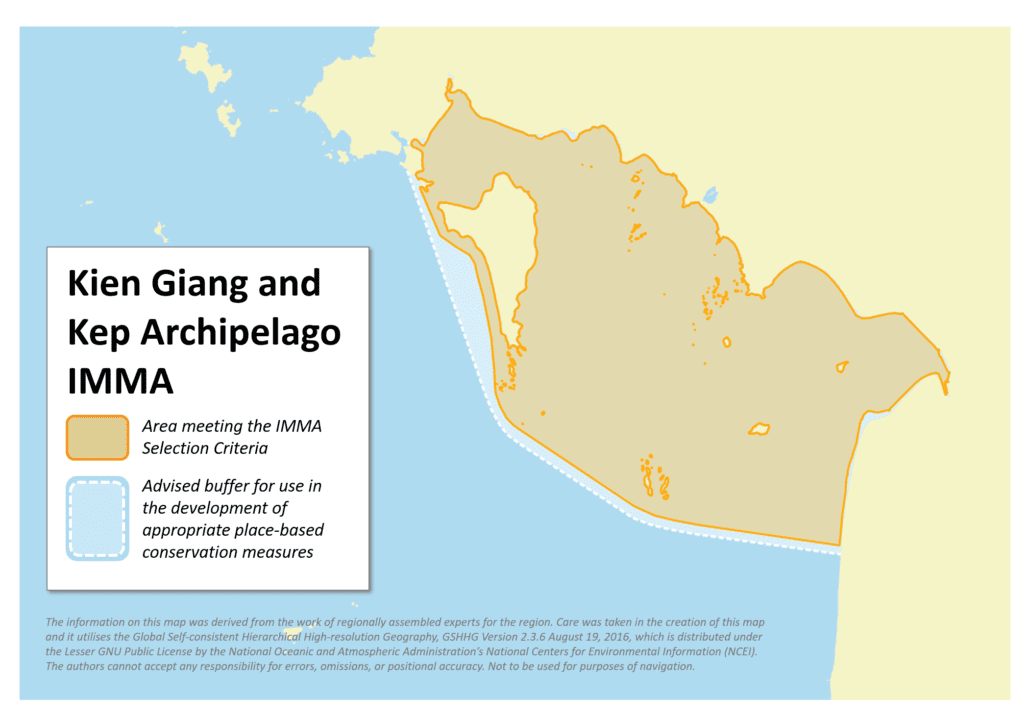Size in Square Kilometres
8,889
Qualifying Species and Criteria
Dugong – Dugong dugon
Criterion A; C (2)
Irrawaddy dolphin – Orcaella brevirostris
Criterion A; C (2)
Criterion D (2) – Marine Mammal Diversity
Other Marine Mammal Species Documented
Balaenoptera edeni, Neophocaena phocaenoides, Pseudorca crassidens, Sousa chinensis, Stenella attenuata, Tursiops aduncus
Summary
The Kien Giang and Kep Archipelago IMMA covers the coastal waters of Kien Giang province in Vietnam and Kep province in Cambodia. The area contains important habitats for the survival and recovery of Irrawaddy dolphins (Orcaella brevirostris). A combination of mangroves, coral reefs and seagrass beds in the area create exceptionally high productivity that attract marine mammals. The local seagrass beds provide a suitable foraging ground for dugongs (Dugong dugon). The Irrawaddy dolphin is the most frequently sighted cetacean in this area. Sightings of Indo-Pacific finless porpoises (Neophocaena phocaenoides), Indo-Pacific humpback dolphins (Sousa chinensis), Pantropical spotted dolphins (Stenella attenuata), False killer whales (Pseudorca crassidens) and Bryde’s whales (Balaenoptera edeni) have also been recorded. The Kien Giang and Kep Archipelago IMMA contains important foraging habitat of at least two threatened species: the Irrawaddy dolphin and the dugong.
Description of Qualifying Criteria
Criterion A – Species or Population Vulnerability
The IMMA contains habitat that is important for the survival and recovery of the Irrawaddy dolphin (Orcaella brevirostris) and the dugong (Dugong dugon). The Irrawaddy dolphin was listed as Endangered by the IUCN Red list as all known populations have been declining worldwide (Minton et al. 2017). The dugong was recognised as Vulnerable by IUCN due to emerging threats on remaining populations (Marsh and Sobtzick, 2015). Despite of data gaps on the abundance and distribution of the two species in Kien Giang and Kep Archipelago, dugongs and Irrawaddy dolphins are consistently recorded in this area (Vu et al. Forthcoming).
Criterion B – Distribution and Abundance
Sub-criterion B1 – Small and Resident Populations
Sub-criterion B2 – Aggregations
Criterion C: Key Life Cycle Activities
Sub-criterion C1 – Reproductive Areas
Sub-criterion C2: Feeding Areas
The IMMA provides an important nutritional base on which both dugongs and Irrawaddy dolphins depend. The Kien Giang and Kep Archipelago meets this criterion because of its exceptionally high productivity, high prey abundance and the presence of seagrass beds, which are crucial for dugongs (Quang et al. 2005, Hines et al. 2008). For Irrawaddy dolphins on the Vietnam side, fifteen percent of observed activities were feeding behaviours (Vu et al. Forthcoming). On the Cambodian side, there was a statistically significant departure from homogeneity between the four potential behaviour categories observed (Foraging, Travelling, Socialising, Resting), with more Foraging and Travelling than expected. For the dugong, the presence of suitable seagrass beds and interview data (which acquired from local dugong hunters) suggested the dugong forage in this area (Hong, 2003; Quang et al. 2005; Hines et al. 2008; Supkong and Bourne, 2014).
Sub-criterion C3: Migration Routes
Criterion D – Special Attributes
Sub-criterion D1 – Distinctiveness
Sub-criterion D2 – Diversity
Supporting Information
Hines, E., Adulyanukosol, K., Somany, P., Ath, L.S., Cox, N. and Boonyanate, P. 2008. Conservation needs of the dugong Dugong dugon in Cambodia and Phu Quoc Island , Vietnam. Oryx 42:113–121.
Hong, D.P. 2003. The primary assessment on the dugong population in Viet Nam. Pages 64–71 Proceedings on the 4th SEASTAR 2000 Workshop. Kyoto University, Kyoto.
Marsh, H. and Sobtzick, S. 2015. Dugong dugon. The IUCN Red List of Threatened Species 2015: e.T6909A43792211. 8235.
Minton, G., Smith, B.D., Braulik, G.T., Kreb, D., Sutaria, D. & Reeves, R. 2017. Orcaella brevirostris (errata version published in 2018). The IUCN Red List of Threatened Species 2017: e.T15419A123790805. https://dx.doi.org/10.2305/IUCN.UK.2017-3.RLTS.T15419A50367860.en. Accessed on 14 July 2022.
Sukong, P. and Bourne, L.S. 2014. A survey of seagrass beds in Kampot, Cambodia. Thailand: IUCN.
Tubbs, S., Côté, G., Akkaya-Baş, A., Jones, A. and Notman, G. 2019. Sighting and stranding reports of Irrawaddy dolphins (Orcaella brevirostris) and dugongs (Dugong dugon) in Kep and Kampot, Cambodia. Aquatic Mammals. 45(5):563-568.
Tubbs, S., Keen, E., Jones, A. and Thap, R. 2020. On the distribution, behaviour and seasonal variation of Irrawaddy dolphins (Orcaella brevirostris) in the Kep Archipelago, Cambodia. Raffles Bulletin of Zoology. 68: 137-149.
Quang, V.V., Ben, H.X., Vy, N.X. and Cox, N.J. 2005. Conservation of the Dugong (Dugong dugon) in Phu Quoc Islands, Vietnam. A report for BP conservation programme.
Smith, B.D.B., Jefferson, T.A., Leatherwood, S., Ho, D.T., Thuoc, C.V. and Quang, L.H. 1997. Investigations of marine mammals in Vietnam. Asian Marine Biology 14:145–172.
Verutes, G., Tubbs, S., Selmes, N., Clark, D., Walker, P., and Clements, O. 2021. Mapping seasonal distribution and habitat preferences of Irrawaddy dolphins (Orcaella brevirostris) in a Transnational Important Marine Mammal Area. Frontiers in Marine Science. 8.
Vu, L., Truong, A.T., Tran, T.S.N., Nguyen, T.H.T., Le D., Nguyen, N.H. and Hoang, M.D. 2015. Conservation of Cetaceans in Kien Giang biosphere reserve, Vietnam’, paper delivered at 21st Society for Marine Mammalogy Biennial Conference, San Francisco, 13th-18th December 2015
Vu, L. Forthcoming. Conservation of cetacean in Kien Giang biosphere reserve- Vietnam: Challenges and strategies.
Downloads
Download the full account of the Kien Giang and Kep Archipelago IMMA using the Brochure button below:
To make a request to download the GIS Layer (shapefile and/or geojson) for the Kien Giang and Kep Archipelago IMMA please complete the following Contact Form:



